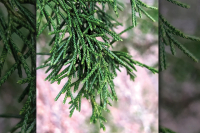Up Moses Creek: A Head of Streaming Hair
 Tsuchinshan-ATLAS streaked across the sky in Western North Carolina on the evening of Oct. 15. Becky Kornegay photo
Tsuchinshan-ATLAS streaked across the sky in Western North Carolina on the evening of Oct. 15. Becky Kornegay photo
Just before sunset on Oct. 15, Becky and I left home for the Jackson County Airport, its runway laid on a flattened-off ridge near Cullowhee named Berry Mountain.
We’d read that a comet christened Tsuchinshan-ATLAS was passing close to Earth, and we’d heard that the airport parking lot was a good place to see it.
We scanned the darkening western sky from there for an hour, while a chill wind whipped across the pavement and cars came and went, most of them, to judge by the throbbing music inside, containing young people. I don’t know why the young ones were driving up there to park, but I am sure it was not to get out and look up. Then, as stars began to appear, a pole light switched on. Designed to not throw obscuring light pollution up into the sky, it cast its light down and into our eyes, polluting them. With apologies to W. B. Yeats, his poem “Crazy Jane Talks with the Bishop”:
“Eye and sky are near of kin,
And sky needs eye,” I cry.
I was sweeping the sky with binoculars when, as if through a porthole in Starship Earth, I spotted a fuzzy white dot with a contrail fanning out behind. The contrail made the comet look like it was hurtling westward — though from where we stood it remained frozen in place.
Related Items
Another sky gazer walked up to ask for a reference point. “Look midway between Venus and that big orange star, Arcturus,” I said.
It wasn’t until I turned from the comet, however, and walked across the parking lot to look east down Berry Mountain that I saw what struck me most: the lights of Cullowhee. They formed a mini-constellation of humanity cupped in the massive black hands of the Great Balsam and Cowee Mountains — mountains, geologists tell us, that stood there 80,000 years ago when Tsuchinshan-ATLAS last passed and long before the two-legged being that looks both up and down and names the things it sees came on the scene.
“The sun is not so central as a man,” says Thoreau. He meant it is not sunlight or any natural light that illuminates and warms the world, but it is the human heart and mind bringing the world forth to mean now in one way, now in another, that “radiate light and heat” to it, and without which the world is “simple, almost to barrenness.” The world is a kind of clay in the hands of the mind that holds it.
Then I recognized a pointed silhouette jutting up out of the blackness on the far side of Cullowhee. It was Coward Knob. Our house, I knew, lay at its base, and Moses Creek was flowing past it. I could make out the ridge that leads from our backdoor up to the summit.
At my back the twilight and stars and planets and waxing moon and Tsuchinshan-ATLAS itself all combined to cast a pale glow on the cliff near the knob’s summit. People living in the valley in 1940 said that under the pounding rain of a “thunderspout” one pitch-black August night, the soil and forest that had been there gave way and roared down the slope. In seconds the mountain’s rock core was laid bare. Nature shapes clay in her own way.
We were almost home from the airport, truck heater on high, when Becky said, “I wonder if we can see the comet from Judaculla Rock?” Judaculla Rock is a large boulder at the bottom of Coward Knob, its surface covered with Cherokee petroglyphs. Even before stopping, I could see the comet through the truck window. And when we got out — Ah! — there was no cold wind, no cars coming and going, no throbbing music, no pole light — only cows grazing in a pasture below a dark sky. The cows, like the young people at the airport, did not look up.
But all those above “no’s” added up to an eye full of “yes!” We could see the comet’s bright center, as if the sun had left behind a particle of itself. And from that spark a cloud of glory streamed behind — or strands of silver hair. Our word “comet” comes from the ancient Greek “kometes,” which means “a head of streaming hair.” Or maybe it was the streaming hair of the Cherokee’s mythical “Judaculla,” a slant-eyed giant said to have leaped down from the Great Balsams to the big rock that bears his name. His nails scratched the rock when he landed. And now, 80,000 years later — what’s human time to a superhuman being? — he’d leaped again, this time toward the departed sun.
Suddenly we felt the warm muzzles of cows through the pasture fence. And Coward Knob rose beside us, a wall of black.
Tsuchinshan-ATLAS? I‘d name that comet Judaculla — or Crazy Jane.













